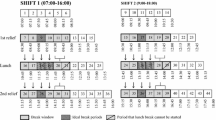Abstract
This paper considers a shift scheduling problem that includes different forms of flexibility in terms of shift starting times, break lengths and break placement. Two particular forms are studied: fractionable breaks and work stretch duration restrictions. Unlike standard breaks, fractionable breaks are not required to be attributed as a whole. They can be divided into fractions of breaks under some conditions. The distribution of breaks within a shift is done with respect to work stretch duration restrictions to ensure a correct mix of periods of work and rest. Two implicit models are proposed. They extend previous work on implicit modeling of break placement to incorporate the concepts of fractionable breaks and work stretch duration restrictions. In this context, we show the merits of using the so-called forward and backward constraints to model work stretch duration restrictions. We also introduce a new formulation of the forward and backward constraints and demonstrate that it considerably reduces the density of the constraint matrix of the two proposed models. Finally, we study the impact of fractionable breaks and work stretch duration restrictions and show that, for some instances, the use of these concepts considerably reduces the workforce size when compared to other traditional approaches.
Similar content being viewed by others
References
Addou, I., & Soumis, F. (2007). Bechtold–Jacobs generalized model for shift scheduling with extraordinary overlap. Annals of Operations Research, 155(1), 177–205.
Aykin, T. (1996). Optimal shift scheduling with multiple break windows. Management Science, 42, 591–602.
Aykin, T. (1998). A composite branch and cut algorithm for optimal shift scheduling with multiple breaks and break windows. Journal of the Operational Research Society, 49, 603–615.
Aykin, T. (2000). A comparative evaluation of modeling approaches to the labor shift scheduling problem. European Journal of Operational Research, 125, 381–397.
Bailey, J. (1985). Integrated days off and shift personnel scheduling. Computers and Industrial Engineering, 9, 395–404.
Bailey, J., & Fields, J. (1985). Personnel scheduling with flexshift models. Journal of Operations Management, 5, 327–338.
Baker, K. R. (1976). Workforce allocation in cyclic scheduling problems: A survey. Operational Research Quarterly, 27, 155.
Bard, J. F., Binici, C., & deSilva, A. H. (2003). Staff scheduling at the United States Postal Service. Computers & Operations Research, 30, 745–771.
Bartholdi, J. J. (1981). A guaranteed-accuracy round-off algorithm for cyclic scheduling and set covering. Operations Research, 29, 501–510.
Bechtold, S. E., & Jacobs, L. W. (1990). Implicit modeling of flexible break assignments in optimal shift scheduling. Management Science, 36, 1339–1351.
Bechtold, S. E., & Jacobs, L. W. (1993). Labor utilization effects of labor scheduling flexibility alternatives in a tour scheduling environment. Decision Sciences, 24, 148–166.
Bechtold, S. E., & Jacobs, L. W. (1996). The equivalence of general set-covering and implicit integer programming formulations for shift scheduling. Naval Research Logistics, 43, 233–249.
Brusco, M. J., & Jacobs, L. W. (1995). Cost analysis of alternative formulations for personnel scheduling in continuously operating organisations. European Journal of Operational Research, 86, 249–261.
Brusco, M. J., & Jacobs, L. W. (2000). Optimal models for meal-break and start-time flexibility in continuous tour scheduling. Management Science, 46, 1630–1641.
Çezik, T., & Günlük, O. (2004). Reformulating linear programs with transportation constraints with applications to workforce scheduling. Naval Research Logistics, 51, 275–296.
Dantzig, G. B. (1954). A comment on Edie’s traffic delays at toll booths. Operations Research, 2, 339–341.
Desaulniers, G., & Hickman, M. (2007). Public transit. In G. Laporte & C. Barnhart (Eds.), Handbooks in operations research and management science, transportation (Vol. 14, pp. 69–127). Amsterdam: Elsevier.
Gaballa, A., & Pearce, W. (1979). Telephone sales manpower planning at Quantas. Interfaces, 9, 1–9.
Henderson, W. B., & Berry, W. L. (1976). Heuristic methods for telephone operator shift scheduling: an experimental analysis. Management Science, 22, 1372–1380.
Keith, E. G. (1979). Operator scheduling. AIIE Transactions, 11, 37–41.
Moondra, S. L. (1976). An L.P. model for workforce scheduling in banks. Journal of Bank Research, 6, 299–301.
Rekik, M. Cordeau, J.-F. Soumis, F. (2004). Using Benders decomposition to implicitly model tour scheduling. Annals of Operations Research, 128, 111–133.
Rekik, M., Cordeau, J.-F., & Soumis, F. (2008). Solution approaches to large shift scheduling problems. RAIRO Operations Research, 42, 229–258.
Segal, M. (1974). The operator scheduling problem: a network flow approach. Operations Research, 22, 808–824.
Thompson, G. M. (1995). Improved implicit optimal modeling of the labor shift scheduling problem. Management Science, 41, 595–607.
Author information
Authors and Affiliations
Corresponding author
Rights and permissions
About this article
Cite this article
Rekik, M., Cordeau, JF. & Soumis, F. Implicit shift scheduling with multiple breaks and work stretch duration restrictions. J Sched 13, 49–75 (2010). https://doi.org/10.1007/s10951-009-0114-z
Received:
Accepted:
Published:
Issue Date:
DOI: https://doi.org/10.1007/s10951-009-0114-z




